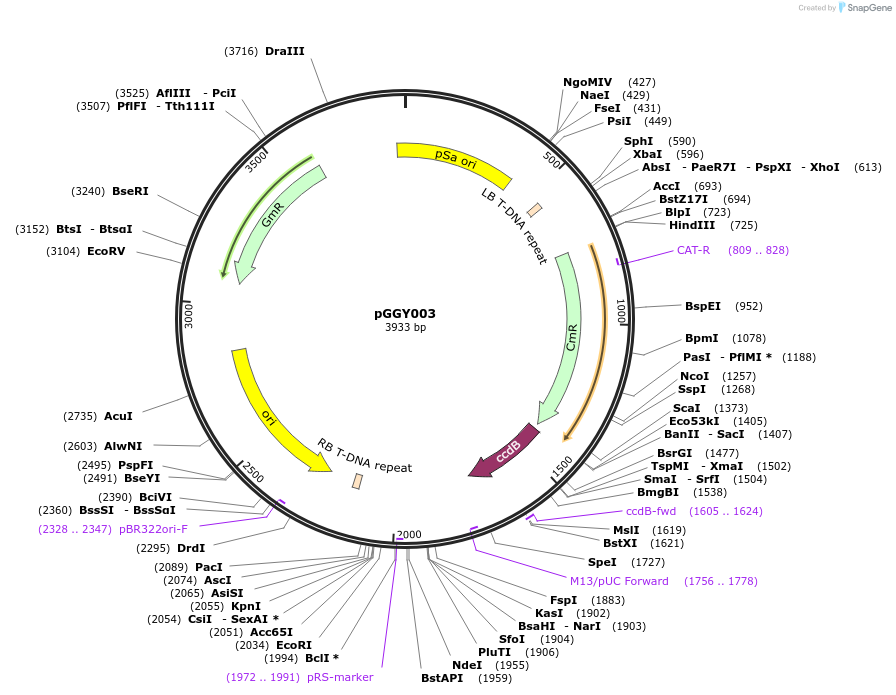pGGY003
(Plasmid
#48867)
-
Purpose(Empty Backbone) Empty destination vector for creating a GreenGate plant transformation plasmid with the plant resistance cassette at the T-DNA left border.
-
Depositing Lab
-
Sequence Information
Ordering
| Item | Catalog # | Description | Quantity | Price (USD) | |
|---|---|---|---|---|---|
| Plasmid | 48867 | Standard format: Plasmid sent in bacteria as agar stab | 1 | $89 | |
Backbone
-
Vector backbonepGreenII
- Backbone size (bp) 2492
-
Vector typeGolden Gate compatible plant transformation vector
Growth in Bacteria
-
Bacterial Resistance(s)Chloramphenicol and Gentamicin, 25 & 10 μg/mL
-
Growth Temperature37°C
-
Growth Strain(s)DB3.1
-
Growth instructionsThis plasmid should be grown at reduced gentamycin concentration (5 µg/mL).
-
Copy numberHigh Copy
Gene/Insert
-
Gene/Insert nameNone
Resource Information
-
Addgene Notes
Terms and Licenses
-
Academic/Nonprofit Terms
-
Industry Terms
- Not Available to Industry
Trademarks:
- Zeocin® is an InvivoGen trademark.
Depositor Comments
This plasmid is designed as destination vector for Golden Gate cloning using the BsaI enzyme. The 5' BsaI overhang can be exchanged using KpnI and EcoRI. The 3' BsaI overhang can be exchanged using XhoI and XbaI. There is also a a NotI-PacI-SgsI-SfaAI-KpnI MCS in front of the A-overhang and an XbaI-PaeI MCS after the G-overhang.
Plasmid Features (listed as bp in full plasmid sequence):
BsaI site #1 = 602-612bp
BsaI site #2 = 2040-2050bp
These plasmids were created by your colleagues. Please acknowledge the Principal Investigator, cite the article in which the plasmids were described, and include Addgene in the Materials and Methods of your future publications.
-
For your Materials & Methods section:
pGGY003 was a gift from Jan Lohmann (Addgene plasmid # 48867 ; http://n2t.net/addgene:48867 ; RRID:Addgene_48867) -
For your References section:
GreenGate - A Novel, Versatile, and Efficient Cloning System for Plant Transgenesis. Lampropoulos A, Sutikovic Z, Wenzl C, Maegele I, Lohmann JU, Forner J. PLoS One. 2013 Dec 20;8(12):e83043. doi: 10.1371/journal.pone.0083043. PubMed 24376629



